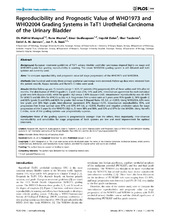| dc.contributor.author | Mangrud, Målfrid Ok | en_US |
| dc.contributor.author | Waalen, Rune | en_US |
| dc.contributor.author | Gudlaugsson, Einar | en_US |
| dc.contributor.author | Dalen, Ingvild | en_US |
| dc.contributor.author | Tasdemir, Ilker | en_US |
| dc.contributor.author | Janssen, Emilius Adrianus Maria | en_US |
| dc.contributor.author | Baak, Jan P.A. | en_US |
| dc.date.accessioned | 2015-03-23T13:33:21Z | |
| dc.date.available | 2015-03-23T13:33:21Z | |
| dc.date.issued | 2014-01-07 | eng |
| dc.identifier.issn | 1932-6203 | |
| dc.identifier.uri | https://hdl.handle.net/1956/9615 | |
| dc.description.abstract | Background: European treatment guidelines of TaT1 urinary bladder urothelial carcinomas depend highly on stage and WHO1973-grade but grading reproducibility is wanting. The newer WHO2004 grading system is still debated and both systems are currently used. Aims: To compare reproducibility and prognostic value (of stage progression) of the WHO1973 and WHO2004. Methods: One hundred and ninety-three primary urothelial carcinomas were reviewed. Follow-up data were retrieved from the patient records. Kappa statistics and Harrell's C-index were used. Results: Median follow-up was 75 months (range 1–127). 17 patients (9%) progressed, 82% of these within and 18% after 60 months. The distribution of WHO73-grades 1, 2 and 3 was 23%, 51% and 26%, interobserver agreement for each individual grade was 66% (kappa = 0.68), while for grades 1&2 versus 3 89% (kappa = 0.68). Intraobserver reproducibility was 68–63% for WHO73 and 88–89% for WHO73 as 1&2 vs.3. Progression free survival rates at 5 years were 95% (grade 1), 98% (grade 2) and 82% (grade 3) and 96% and 82% for grades 1&2 versus 3 (Hazard Ratio, HR, 5.4, p = 0.003). Using WHO2004, 62% were low grade and 38% high grade, inter-observer agreement 87% (kappa = 0.70), intraobserver reproducibility 93%, and progression free 5-year survival rates 97% and 85% (HR 6.6, p = 0.004). Positive and negative predictive values for stage progression within 5 years for the WHO73 (1&2 vs. 3) were 18% and 96%, and 15% and 97% for the WHO04. Using Harrell's C-index, none of the grading systems was prognostically superior. Conclusion: None of the grading systems is prognostically stronger than the others. Most importantly, inter-observer reproducibility and sensitivities for stage progression of both systems are low and need improvement for optimal treatment. | en_US |
| dc.language.iso | eng | eng |
| dc.publisher | Public Library of Science | eng |
| dc.rights | Attribution CC BY | eng |
| dc.rights.uri | http://creativecommons.org/licenses/by/4.0/ | eng |
| dc.title | Reproducibility and prognostic value of WHO1973 and WHO2004 grading systems in TaT1 urothelial carcinoma of the urinary bladder | en_US |
| dc.type | Peer reviewed | |
| dc.type | Journal article | |
| dc.date.updated | 2015-03-03T15:39:14Z | en_US |
| dc.description.version | publishedVersion | en_US |
| dc.rights.holder | Copyright 2014 Mangrud et al. This is an open-access article distributed under the terms of the Creative Commons Attribution License, which permits unrestricted use, distribution, and reproduction in any medium, provided the original author and source are credited | |
| dc.source.articlenumber | e83192 | |
| dc.identifier.doi | https://doi.org/10.1371/journal.pone.0083192 | |
| dc.identifier.cristin | 1128182 | |
| dc.source.journal | PLoS ONE | |
| dc.source.40 | 9 | |
| dc.source.14 | 1 | |
| dc.subject.nsi | VDP::Medical sciences: 700::Clinical medical sciences: 750::Nephrology, urology: 772 | eng |
| dc.subject.nsi | VDP::Medisinske fag: 700::Klinisk medisinske fag: 750::Nefrologi, urologi: 772 | nob |

